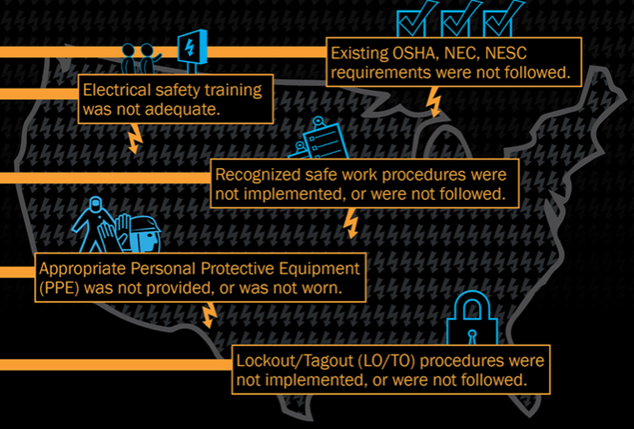by Brianna Crandall — February 29, 2016—Electrical workplace fatalities have steadily decreased over the last few decades, according to statistics cited by safety and visual communication solutions provider Graphic Products. From 1992-1996, an average of 327 workers died in the United States each year. Between 2009 and 2013, that number dropped to an average of 161.
Despite the uplifting trend, electrical injuries, even non-fatal injuries pose a serious threat, reminds the company. Graphic Products has published an Electrical Injuries Infographic that outlines workplace fatalities and injuries, and highlights not only the workers at risk but the cost of those accidents in the workplace.

The Electrical Injuries Infographic outlines workplace fatalities and injuries, and highlights not only the workers at risk but the cost of those accidents in the workplace.
The informative visual dives into the details, pulling from a collection of studies from the U.S. Bureau of Labor and Statics (BLS) and the National Institute of Occupational Safety and Health (NIOSH), to highlight major trends in electrical injuries. According to reports, construction workers are at highest risk of both electrical fatalities and non-fatal injuries. Furthermore, the single most important part of an electrical safety program is said to be effective electrical and arc flash training.
“You can write all the procedures you want, and provide every piece of PPE that’s out there,” commented Jeff Woods, safety compliance analyst at Graphic Products. “But if you haven’t trained your workers to follow those procedures, or to wear that PPE, then none of it matters.”
According to NIOSH, five factors cause or influence electrical accidents, including:
- Inadequate electrical safety training
- Failure to follow OSHA, National Electrical Code and National Electrical Safety Code requirements
- Lack of lockout / tagout procedures and implementation
- Failure to implement and follow recognized safe work procedures
- Inadequate use of or failure to use or provide personal protective equipment (PPE)
Woods concluded, “Proper training is what keeps your workers from becoming statistics.”
Graphic Products provides safety training materials, educational resources, and up-to-date news and compliance information on topics like arc flash, chemical labeling, and pipe marking.





